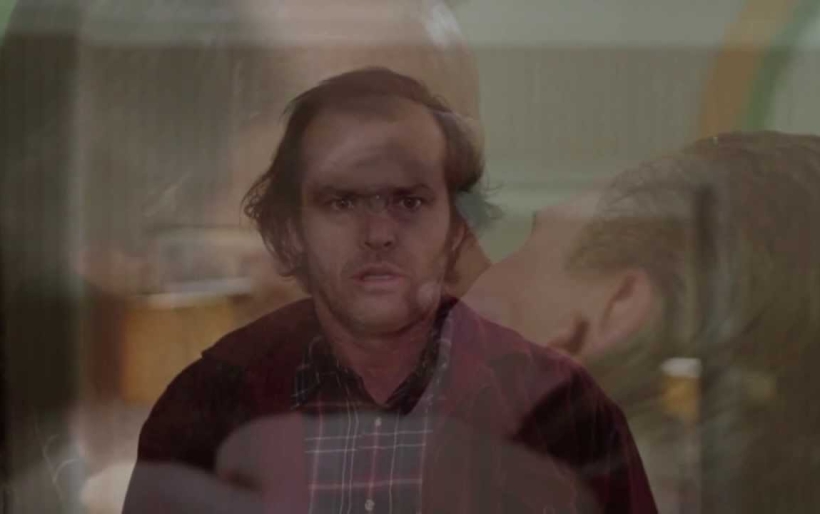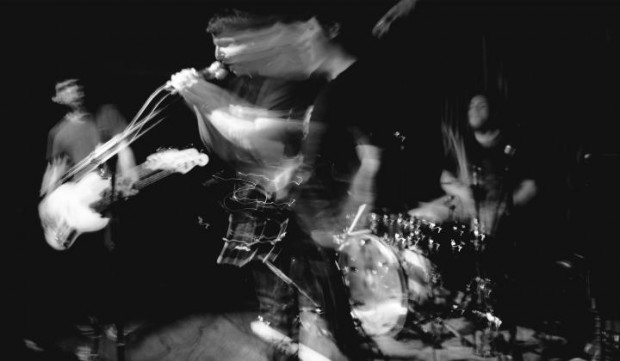
Going inside, around and behind Kubrick’s The Shining with soundtrackers Psychic Teens
Stanley Kubrick’s 1980 thriller The Shining is, by the estimation of many film buffs, one of the most complex and intense pieces of cinema ever made. Is it visually arresting, and harnesses sonic minimalism brilliantly to strike unsettling moods. Those who have spent any amount of time in a dark theater or an empty apartment watching the film know that it doesn’t deliver the type of horror where a dude in a mask jumps out and goes “BOO!” – it is the type of horror that sticks with you long after the credits have rolled.
The 2012 documentary Room 237 is a must-view for any fan of The Shining, whether you’ve watched it once or dozens of times. The film digs deep below the surface of already-tangled picture, espousing various analyses and hypotheses that range from plausable to odd-but-intriguing to looney conspiracy theorist.
Falling somewhere in the middle of that spectrum is the idea that if you watch simultaneous versions of The Shining – one starting at the beginning and moving forward and one in reverse, projected on top – scenes line up in strange, unexpected and possibly subliminally symbolic ways. In one sequence, Jack Nicholson’s face matches perfectly with the contours of a wall clock. Elsewhere, the grimacing ghost twins line up with Shelly Duvall running, frightened, in the snow. An injured Danny lies overtop the elevator of blood opening its doors.
The simultaneous screening was first staged in Brooklyn by artist, researcher and enthusiast John Fell Ryan. He took the idea from a heady film analysis that refers to The Shining as “a film organized with logic that flows both backwards and forwards” and says it “even seems to operate backwards, which means the film is a mirror of itself through time. The Shining is a film meant to be seen both forwards and backwards.” In his experiment, Ryan took that literally.
Tomorrow night, the Cinedelphia Festival will re-create Ryan’s The Shining, Forwards and Backwards, Simultaneously Superimposed at PhilaMOCA with a live score performed by Philadelphia noise-punk three-piece Psychic Teens, a band that’s no stranger to ambiance and mood-setting. I swapped e-mails with the band for some perspective on the project and what we can expect.

Psychic Teens | Photo by Oren H Echtman
The Key: How did Psychic Teens first hear of The Shining backwards-forwards simultaneous projection phenomenon? Had you seen it in person before this project came about?
Psychic Teens: We weren’t aware of it until we’d heard about it in Rodney Ascher’s Room 237 documentary.
TK: What’s your read on the instances of stuff lining up between the two…interesting and eerie coincidences, or intentional arrangement on the part of Kubrick?
PT: It could be neither a coincidence nor a planned thing. It’s likely a reflection of a very methodical and obsessive filmmaker and the way that he created and laid out his vision, leading to things meeting up in interesting ways. Similarly, the entire film is visually stunning…of course it’s going to look even more incredible when you double the amount of imagery on the screen. Eerie is an understatement. Now we’re interested in further investigation of his other films in this manner. No spoilers – but the symmetry within the center portion of the film is crazy intense.
TK: How is Psychic Teens going to approach this performance? Will you play your songs? Will you reference any of the music used in the film…like the super-ominous score or the classical/modern stuff by Ligeti and Bartok or the big band stuff?
PT: Once we figured out basic notes, we began to figure out where we wanted to go with this. We’re mostly approaching it as a long Psychic Teens piece; not wholly different than what we usually do stylistically, but spread out over a longer period of time. We focused more on building/releasing tension rather than (relatively) short bursts of noise. It’s almost like a Curb Your Enthusiasm episode – we know where the beats have to be within the context of whats on screen, but there is enough leeway for some improv to add color. We had to think a lot more about mood and open space than we would in the context of our songs. There are little bits of our songs here and there, though in some cases the key was changed to fit with the overall piece. We used the original score as kind of a jumping off point, and kept our parts in the same key as the score for parts of the movie where we’ll let the film’s audio bleed through.
We were influenced by a lot of post rock, noise rock, Hawkwind, Acid Mothers Temple, etc – its trippy and heavy!
TK: What makes The Shining so chilling isn’t only the stuff you see happening, but also the way sound shapes how you experience it. How do you plan on reflecting that?
PT: We think we’ve worked our arrangement out in a way that really highlights the tension that permeates the entire movie. The idea is definitely to have what’s happening on screen reflected in our performance. We mapped the movie out to highlight the visual element; it’s not just going to be us “jamming” for 2 and a half hours. Within the first practice, we quickly realized that the pacing and tone of the dialogue was extremely integral to the Shining experience. So instead of muting the audio completely, we will manipulate and incorporate elements of the sound design and dialogue in the performance.
Also — we’ve discussed this at practice a few times, but the forwards + backwards video mixed with volume and other things we’re doing makes the whole experience really disorienting. To us, that’s why the original score succeeds so much — it’s very harsh and not your typical movie score. We tried to take that approach with what we came up with for this screening.
TK: How does a band even begin rehearsing for a show like this? Did you play along to the film in your rehearsal space?
PT: Thanks to the internet, we were able to practice with the finished product as opposed to just the forward running film. We brought a TV down into the basement and played along with it. A lot. We mapped out different scenes and covered a good portion of a whiteboard with ideas. It was mostly going through the film, discussing what would or wouldn’t fit with each scene, and then trying it out. Also, we tried a lot of just playing while watching it and seeing what we came up with. Several parts that we ended up sticking with came out of picking apart what we’d done when we were just winging it while watching.
TK: The movie is two and a half hours long. Do you perform for the full thing?
PT: There are a few lulls, but we’re pretty much playing the entire time. We came up with some semi-creative ways (we think) to keep everyone from getting either overwhelmed or bored by it. Its not going to be us playing straight on, at full volume, for 2 and a half hours. It’s by far the longest single piece of music any of us have taken part in writing, so a really tricky thing was learning to reel in the need to constantly make noise and let it build for considerable amounts of time. There are maybe 4 minutes during the entire program where the guitars don’t make a sound. The hardest part will be not taking any bathroom breaks. (We’re old!)
TK: What’s Psychic Teens’ experience with projections and live-scoring been like before this show? Do you think you’ll do more things like it?
PT: We did our first live score for the film Dementia around Halloween of last year. WKDU invited us to be part of a Tune Out Tuesday event that they were curating, and it sounded like fun. It was after that screening that we ended up talking to the folks at PhilaMOCA about planning something for Cinedelphia. Dementia is completely silent and only about 50 min long, though, so it was a much different undertaking. The whole experience of preparing this has been really cool and unique and something new for this band. We’d love to give another film a shot after we have some time to recuperate from this one!
See Psychic Teens perform The Shining, Backwards and Forwards, Superimposed Simultaneously Tuesday, April 22 at PhilaMOCA for the Cinedelphia Festival. Tickets and information on the all-ages show can be found here.
